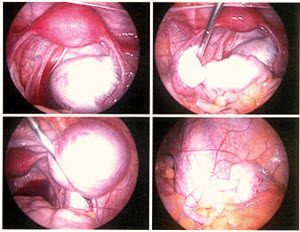Endometriosis is a condition where a type of tissue called endometrium grows outside the uterus. Endometrium is supposed to line the uterus, and when it appears in other parts of the body it can cause health problems and infertility issues. In a person with endometriosis, endometrium can for instance grow in the fallopian tubes and in and around the bladder and bowel.
Causes of endometriosis
The cause of endometriosis remains unknown. Here are a few examples of possible causes that are currently being explored in research concerning endometriosis.
- Retrograde menstruation. According to this theory, endometriosis occurs when womb lining tissue that should be expelled from the body during a woman’s menstruation instead flows up through the fallopian tubes and embeds itself on other organs.
- Endometrium cells spreads through the bloodstream.
- Endometrium cells spreads through the lymphatic system.
- A problem with the immune system.
- Genetic causes. There is probably a genetic component in endometriosis, because it tends to run in families. Also, the incidence of endometriosis is higher is some ethnic groups than in others.
Some of these possible explanations may be overlapping; if endometriosis is related to a problem with the immune system there might be a genetic component causing some people to be more prone to develop this immunological problem, an so on.
Endometriosis chiefly affects girls and women of childbearing age. It does occur in post-menopausal women, but the condition is much more rare in this group.
Symptoms
The strenght of the symptoms can vary a lot between different individuals. Some women with endometriosis develop very bad symptoms that have a large negative impact on their everyday life, while others experience less severe symptoms or hardly any symptoms. Some individuals with endometriosis notice no symptoms at all and the endometriosis is only discovered when the seek medical care for some other condition, e.g. infertility.
Examples of symptoms
- Severe period pains. In some women with endometriosis, taking over-the-counter painkillers against this pain produce no or little effect.
- Pelvic pain all the time or around the time of the period
- Heavy periods with abnormally large blood loss
- Pain during sexual intercourse
- Pain after sexual intercourse
- Pain or discomfort when urinating or defecating
- Bleeding from the anus
- Blood in feces
- Feeling tired all the time
Diagnosing endometriosis based on symptoms only is difficult, because there are several other conditions that can cause similar symptoms. You may therefore need to have key hole surgery (laparoscopy) to confirm endometriosis.
Treatment
There is currently no cure for endometriosis, but there are treatments that may help reduce the symptoms.
- Non-steroid anti-inflammatory painkillers (NSAIDs)
- Hormonal treatments, such as gonadotrophin-releasing hormone (GnRH) analogues. For some women, standard hormonal contraceptives will improve the condition. Examples of such hormal contraceptions are the combined contraceptive pill, the contraceptive patch and the intrauterine system (IUS).
- Surgery to remove endometriosis tissue
- Surgery to remove organs (or part of organs) affected by endometriosis.
Endometriosis and fertility
One of the complications of endometriosis is decreased fertility. Endometriosis can make it difficult or impossible to get pregnant without medical intervention.
Endometriosis can cause injury to the ovaries or fallopian tubes, and in vitro fertilisation (IVF) can be required. Regrettably, women with endometriosis have a lower chance of getting pregnant with IVF than women without endometriosis.
